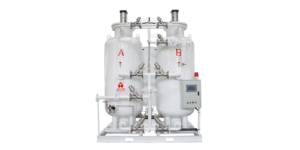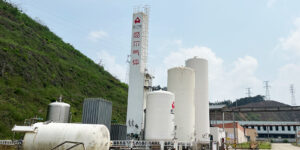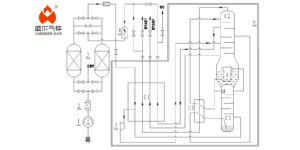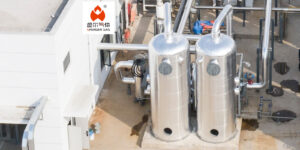Air separation unit and liquid nitrogen generators are both used to produce liquid N2, but their principles and working methods are different. Generally speaking, cryogenic air separation unit are suitable for that require higher purity of LN2. While liquid nitrogen generators are more suitable for scenarios that have lower cost requirements and less stringent purity. This article will explain in detail how to distinguish between these two equipment and make a choice based on actual needs.
The Principles of ASU and Liquid Nitrogen Generators
Cryogenic Air Separation Units
These units utilize air separation technology, leveraging the separation effect during the deep cooling process to separate nitrogen and oxygen from air. Typically, air undergoes a series of compression, cooling, and evaporation processes. Breaking it down into two streams rich in nitrogen and oxygen, respectively.
The nitrogen produced by cryogenic air separation units is usually of high purity. Which suitable for various industrial applications such as metal processing and electronics manufacturing. It typically requires large equipment and complex operations, thus resulting in higher costs.
Liquid Nitrogen Generators
It is usually simpler and more economical devices. Using compressed air or nitrogen and employing membrane separation or adsorbent technologies to separate nitrogen from other components in the air. Compared to cryogenic air separation units, the working principle of liquid nitrogen generators is simpler, as they do not require liquefaction and re-evaporation processes, thus typically resulting in lower costs.
However, the nitrogen produced by liquid nitrogen generators usually does not have as high purity as that from cryogenic air separation units. So additional processing steps may be needed in certain applications to enhance the nitrogen purity.
Selection for High-Purity Nitrogen
For applications requiring high-purity nitrogen (e.g., above 99.9%), using cryogenic air separation units may be more appropriate. This is because cryogenic air separation units typically can provide higher purity nitrogen while maintaining high yields.
Although liquid nitrogen generators can provide high-purity N2 to some extent, their purity is usually slightly lower than that of cryogenic air separation units.
Additionally, due to the simpler working principle and equipment structure of liquid nitrogen generators. Extra processing steps such as using additional gas purification systems or conducting multi-stage separation may be required to handle gases with high purity requirements, thus increasing costs and complexity.
Therefore, for applications with extremely high purity requirements for nitrogen, cryogenic air separation units are usually the better choice. While liquid nitrogen units are generally suitable for applications with purity requirements below 99%.
Price and Lifespan
For nitrogen purities equal to or less than 99%, and if the required flow rate is not high, a small-scale liquid nitrogen generator with a lower initial cost can be chosen. However, for higher nitrogen flow rate requirements, such as needing over 5000L/hour of N2. It is recommended to choose cryogenic air separation units. Despite the higher initial cost, they have a longer lifespan compared to liquid nitrogen generators, resulting in higher overall cost-effectiveness.
For nitrogen purities above 99.9%, considering factors such as after-sales maintenance costs, initial costs, and lifespan. It is advisable to directly choose cryogenic air separation units.
In general, cryogenic air separation nitrogen equipment usually has a longer lifespan and higher durability. But requires more complex maintenance and higher maintenance costs. Small-scale liquid nitrogen unit typically have simpler structures and relatively easier maintenance . But it may has a relatively shorter lifespan and may require additional gas purification processing for high-purity nitrogen requirements.
In conclusion, the choice between cryogenic air separation units and liquid nitrogen generators should be based on specific purity requirements, production capacity needs, budget, and operational costs.








